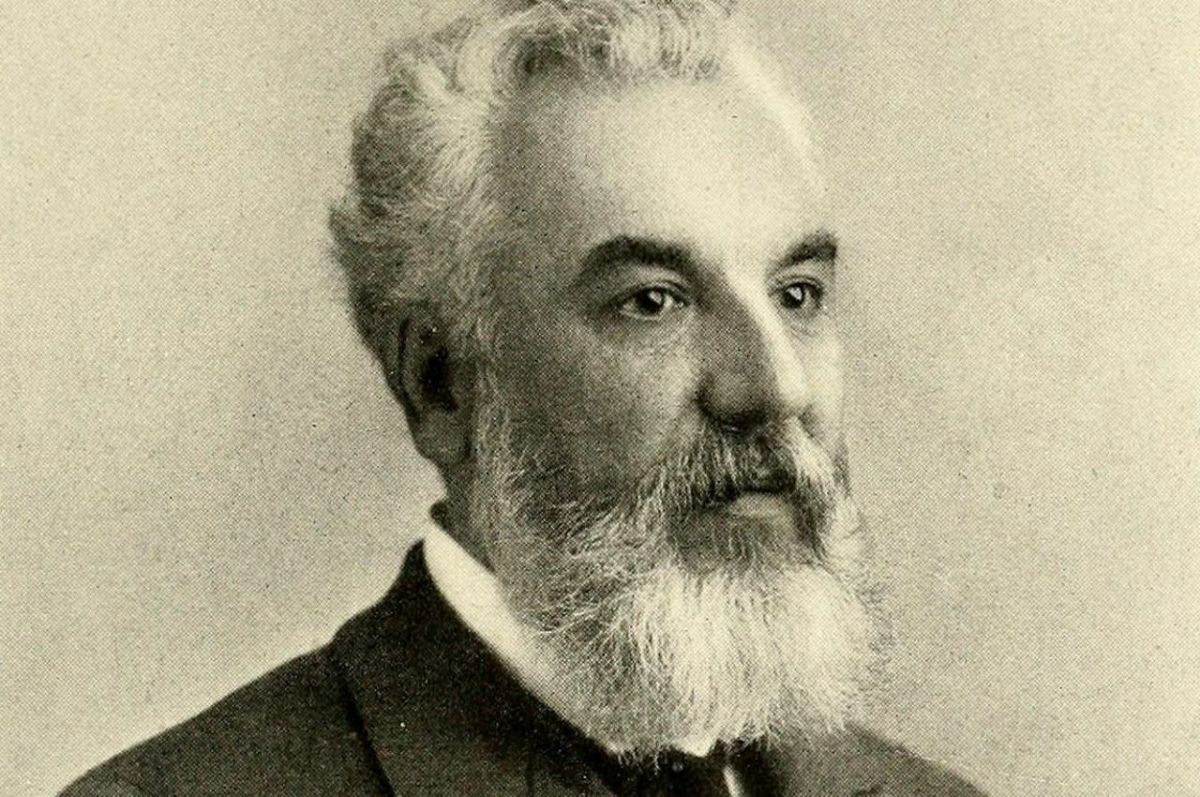How Technology Wiped Out Michigan's Grindstone City
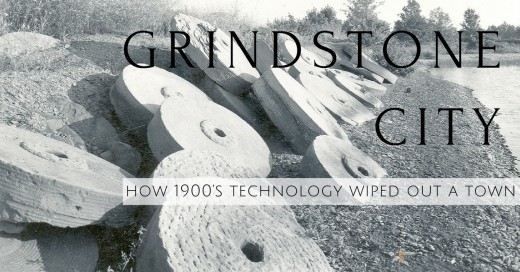
The accidental find of the Marshal Sandstone formation in Michigan's Upper Thumb in 1834 gave rise to one of the areas first industries. Grindstone City became famous for its production of huge grinding wheels until a disruptive technology change slid the industry and the town into obsolescence.
A Great Lakes Storm Starts a New Industry

Seeking shelter from a Great Lakes storm, the schooner the Rip Van Winkle captained by Aaron Peer, came into a natural harbor west of the Pointe Aux Barques lighthouse in 1834. After anchoring and securing his ship, the crew explored the dense virgin forest and rocky beach for shelter and firewood. This was a wilderness of ceder, pine, beech, ash, and maple. The tall cedar canopy was so thick that snow remained in places although it was midsummer. The men came across huge flat rocks lying about the shore and forests.
Captain Peer took some of the pieces of the stone south to Detroit. They found the samples to be impeccably suited for paving streets, replacing Ohio flagstone as the preferred surface. It's said that this stone was used to pave a few blocks on Detroit's Jefferson and Woodward Avenues. It was later used as foundation material on several buildings in Port Huron Michigan.
Within a couple years, Captain Peer and his crew took advantage of the stone to sharpen their tools, and began shaping them into grindstones. Shortly thereafter a small port grew from the natural harbor as his men worked inland bringing the sandy abrasive stone out of the forest.
The Boomtown of Grindstone City
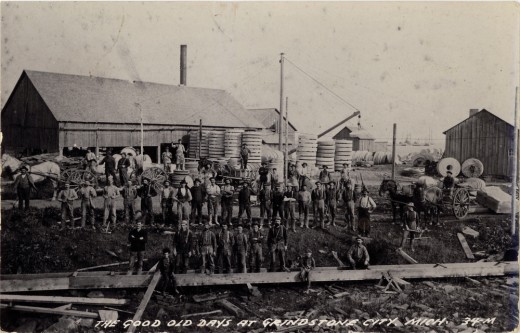
In 1836, Captain Peer purchased 400 acres of land to establish a grindstone quarrying and manufacturing operation. The area that Peer discovered this abrasive stone it's fine grit was unique to the tip of Michigan’s Thumb and part of the of Marshall Sandstone formation. The stone is easy to work with and ideal for shaping. Peer and his team built a horse powered grist mill to make grinding wheels and whetstones. The company produced grindstones that varied from small kitchen grinding wheels to large grinding stones weighing 3 ½ tons or more. The largest stone ever turned out weighed over six tons.
Demand for the large sharpening stone soon earned the Upper Thumb the nickname of Grindstone Capital of the World. The Company town, started with a stone-cutter grist mill, and grew with a wharf out into Lake Huron, two quarries, company store and offices. A salt block was built to extract salty brine and evaporate it. The operation produced 125 barrels of salt each day. By the 1870s the first railroad built was built into Grindstone City to offer less reliance on ships.
Grindstone City became a fast growing industry that produced the largest and finest grindstones, scythestones, and honestones in the world.
New Technology Dooms the Town
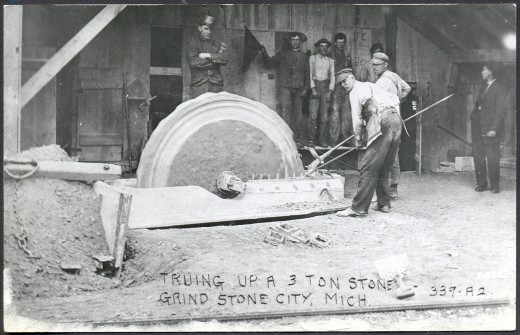
The boomtown days were numbered as new technology was developed. Carborundum was discovered in 1893 by E.G. Acheson. This silicon powder has a crystal structure like that of diamond and is ideal for cutting, grinding, and polishing. Economical to produce, Carborundum started taking the place of grinding stones, and the quarries could no longer be operated at a profit. Grindstone City slid into decline from 1900 and ceased operations in 1930.
Grindstone City Today.
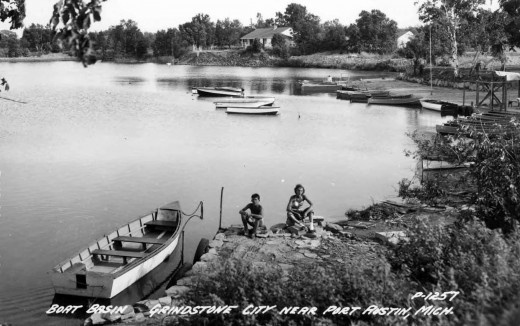
Today Grindstone City is a vacation destination and retirement community. Remnants of the town are still visible. The General Store is still operating as a ice cream and gift shop. The church is now an art gallery. The former headquarters and offices of the quarry operations is now a charming and restored ice cream parlor.
Grindstone City is also known for sports fishing in Lake Huron. Charter boat captains take angelers out in the big lake for salmon, lake trout and brown trout, steelhead, walleye, and yellow perch.
Massive grindstones can still be seen along the shoreline of the long vacant pier that juts out into the lake. The natural harbor still looks as it did in the 1830's when the first grindstone rock was discovered.
Finding Grindstones Today
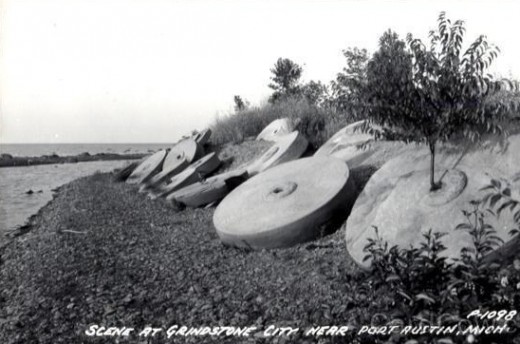
Grindstones can still be seen on the shore north of the city. Abandoned stones littered the beach for years. People started to pick them up and use them as lawn decorations for their cottages in the Upper Thumb. Today only the largest of the old grindstones remain.
Grindstone City
This area is known for its history of making grindstones. Today it draws those with vacation homes and sport fishermen.
Was this article informative?
Have you ever seen or heard of grindstones before reading this article?
Author's Note
Sources:
- Great Lakes Maritime Data Base
- Mabel Cook's "History of Grindstone City New River and Eagle Bay" (1977).
Note: We looked further into the history of the schooner, the Rip Van Winkle. There looks to be a discrepancy on the date that authors state that this ship took refuge from the storm (1834) and records stating when the Rip Van Winkle was built. (1847) The Rip Van Winkle worked on the Great Lakes until 1852 where its recorded as wreaked in Lake Erie. It's likely that Peer commanded or owned the Rip Van Winkle. Research continues.
This content is accurate and true to the best of the author’s knowledge and is not meant to substitute for formal and individualized advice from a qualified professional.
© 2018 Mike Hardy


